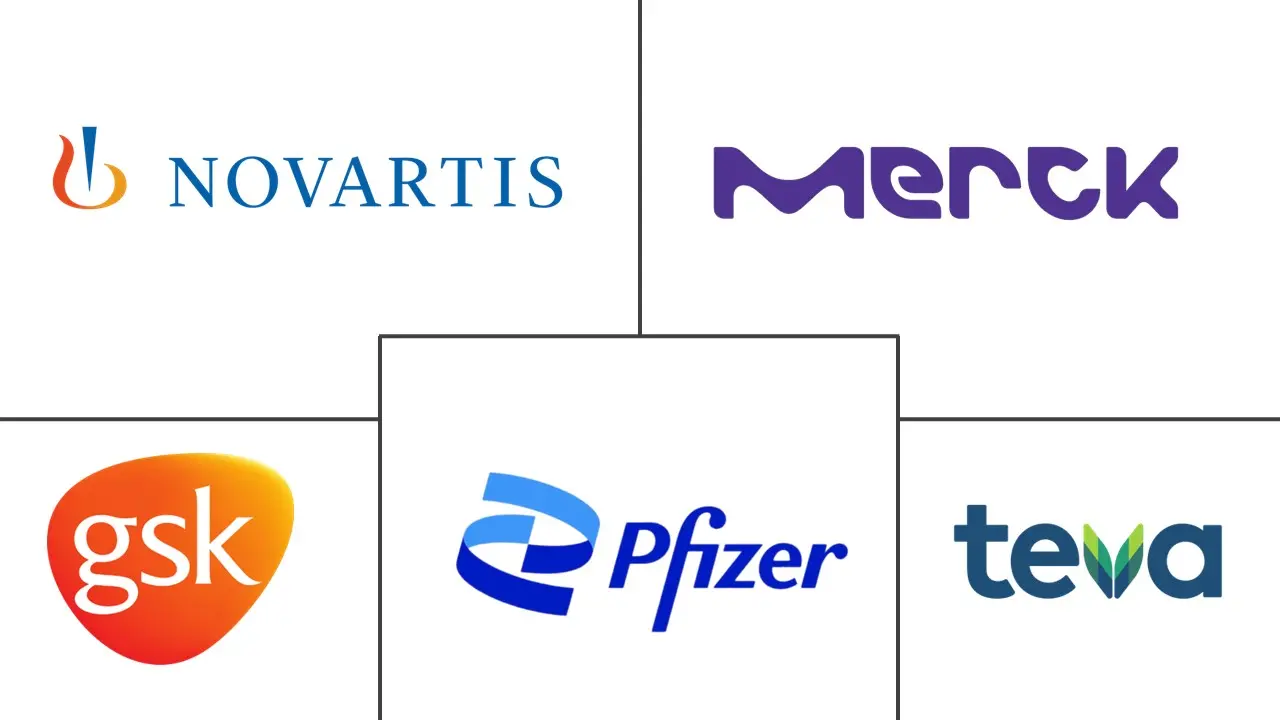Global Neuroprotective Agents Market Size and Share
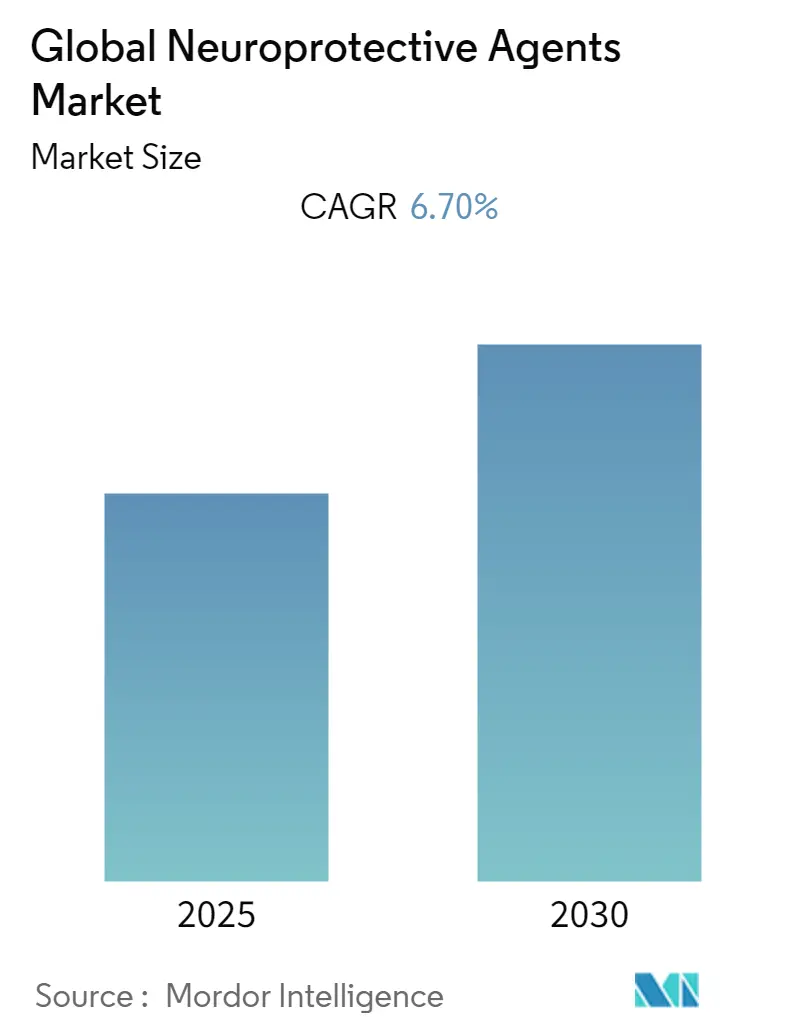
Global Neuroprotective Agents Market Analysis by Mordor Intelligence
The Global Neuroprotective Agents Market is expected to register a CAGR of 6.7% during the forecast period.
The COVID-19 epidemic has had a significant impact on the market. Many COVID-19 patients have shown neurological symptoms and indicators since the outbreak of the COVID-19 pandemic in 2020. According to an article published in January 2021 titled "The Impact of the COVID-19 Pandemic on People with Neurological Disorders: An Urgent Need to Improve the Health Care System's Preparedness," data from Spain, particularly the Madrid area, show that 95% of hospitals have re-allocated neurologists to assist COVID-19 patients, and the number of beds in neurology wards has been reduced by 89%. The pandemic has exposed the lack of sufficient health care for patients with neurological illnesses, particularly in locations where hospital-community integration is already lacking. Thus, COVID-19 increased the chances of neurological damage, which is expected to drive the market growth.
The factors expected to drive the market growth include the increasing prevalence of neurological diseases. Worldwide, neurological illnesses are a leading cause of disability and mortality. The 'big three' neurodegenerative disorders, Alzheimer's disease, Parkinson's disease, and amyotrophic lateral sclerosis, cause significant morbidity and mortality in the aged population across the globe. Neuroprotective medicines are those that help to maintain the structure and function of neurons. Neuroprotective medications have the potential to reduce the 6 million deaths caused by stroke each year. According to the World Health Organization's data updated in February 2022, around 50 million people worldwide suffer from epilepsy every year.
Also, according to the National Health Service (NHS) England updates from April 2022, around 1 in 12,500 people in England will have a ruptured brain aneurysm every year. Furthermore, around 3.0% of adults in the United Kingdom have a cerebral aneurysm. Also, according to the Brain Aneurysm Foundation statistics updated in May 2020, an estimated 6 million Americans are affected by cerebral aneurysms each year. Additionally, as per the Parkinson's Foundation Statistics updated in April 2020, more than one million people were living with Parkinson's disease in the United States by 2020 and nearly 60,000 Americans are diagnosed with Parkinson's disease every year. Thus, in view of the high incidence of neurological disorders globally. Thus, the vast and rapidly growing patient population base for target diseases across the key markets is primarily responsible for the significant volume consumption of neuroprotective agents, leading to market growth.
Secondary biochemical alterations in the brain are caused by traumatic brain injuries and stroke. This causes tissue damage as well as neuronal cell death. Neuroprotective medications help patients avoid subsequent tissue loss and improve their behavioral outcomes. Several clinical trials are looking into this outcome. As per the study published in May 2021, titled 'Traumatic brain injury: Epidemiology, Classification, and Pathophysiology', traumatic brain injury (TBI) is a major source of health loss and disability worldwide. Globally, the annual incidence of TBI is variably estimated at 27 to 69 million. Many survivors live with significant disabilities, resulting in major socioeconomic burden.
The rising frequency of neurological illnesses has prompted several academics and manufacturers to ramp up their research and development efforts in order to create neurological disorder medications for therapy. Various companies from around the world have submitted applications for the most promising neurological illness medications, which are currently in various stages of regulatory approval. Various producers, on the other hand, have previously released medications for neurological disorders. Improving neurological disorder medication research and development efforts are expected to meet the demand for neurological disorder drugs while also increasing the supply of neurological disorder drugs at the most competitive pricing. As a result, the market is being driven by increased research and development for neurological illness medications.
Governments all around the world are focusing more on healthcare infrastructure and taking the required steps to build or change it, as well as advance therapeutic delivery. Over the last few years, the healthcare infrastructure in developing countries has been through major changes by government and regulatory bodies, all of which are aimed at improving healthcare delivery and incorporating all segments of the population. Increased focus on healthcare infrastructure is predicted to boost public investment, reliability, and the pace of diagnosis and treatment, resulting in new prospects for neurological disorders and driving the market.
Global Neuroprotective Agents Market Trends and Insights
The Alzheimer's disease Segment is Expected to Hold a Major Market Share in the Neuroprotective Agents Market
The incidence of Alzheimer's has been constantly increasing, and it is expected to continue increasing in the coming decades. According to the World Health Organization, 2020, nearly 50 million people across the world are living with Alzheimer's disease and other dementias, and the number is expected to reach more than 152 million by 2050. Additionally, according to a research article published in Ageing Research Reviews, 2020, Alzheimer's disease progression increases with aging and is the fifth-largest contributor to the global burden of diseases, accounting for more than USD 1 trillion in 2018, globally.
Furthermore, as per England: Recorded Dementia Diagnosis Data May 2020, one million people in the United Kingdom are projected to be living with dementia by 2025, which may increase to two million by 2050. Among all dementia conditions, 60-70% of cases account for Alzheimer's disease. As a result, there is a large market for Alzheimer's treatment, which would encourage the development of neuroprotective medications. Depression, memory loss, loss of inhibitions, and issues with thinking and reasoning are all classic Alzheimer's symptoms. Physical checks, blood tests, brain imaging, mental status, and neuropsychological testing are commonly used to diagnose it. Alzheimer's disease is becoming more common as the global population ages, which increases the disease's incidence and provides opportunities for growth in the Alzheimer's treatment market.
According to the United Nations' World Population Prospects (WPP), the number of people living with Alzheimer's disease is expected to reach 1.4 billion by 2030, with an annual growth rate of 3%. However, medications for Alzheimer's therapy are in development and are projected to launch in the near future, boosting the market growth. The growth of Alzheimer's disease treatment and the market is attributed to a rise in demand for targeted therapies, an increase in research and development activities for the development of novel drugs and therapies, an increase in cases of Alzheimer's disease among the population, and an increase in expenditure for the development of healthcare infrastructure.
Other factors driving market growth include rising expenditure on healthcare infrastructure development, rising public awareness about the disease in developing regions, increased government initiatives to promote awareness in backward areas, and an increase in the strategic collaboration rate among market players.
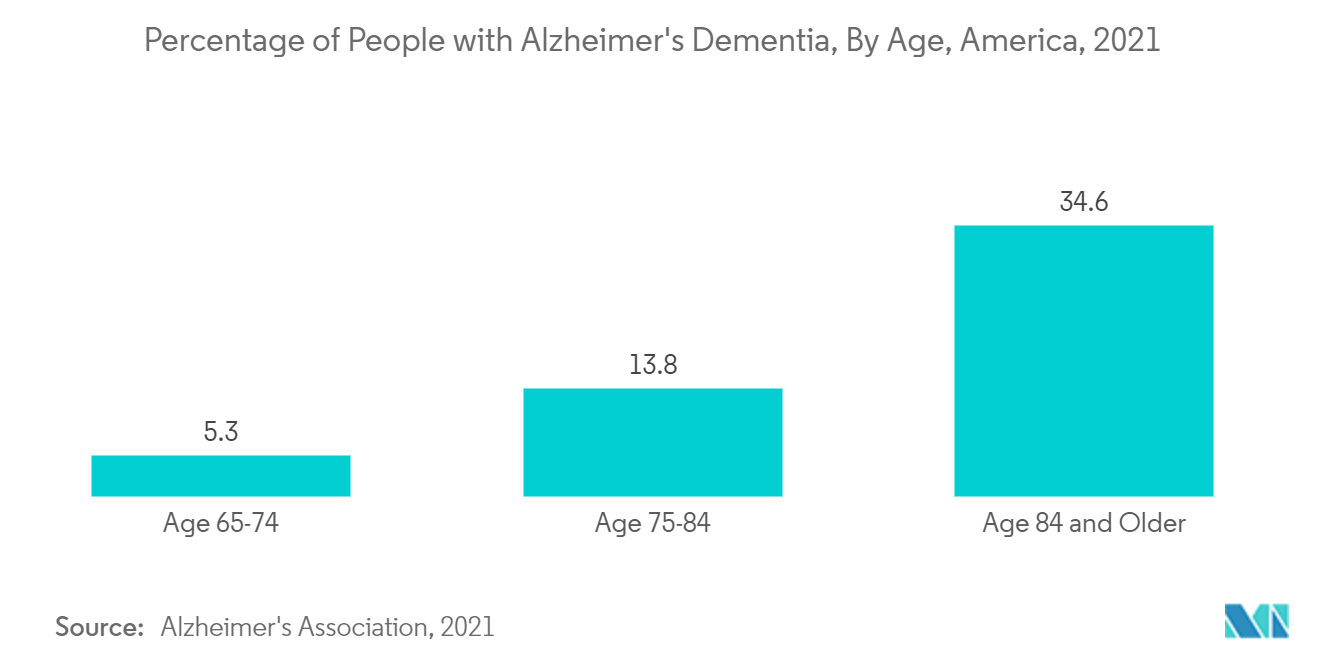
North America is Expected to Hold a Significant Share in the Market and Expected to do Same in the Forecast Period
North America is expected to hold a major market share in the global Neuroprotective Agents Market. According to the Parkinson's Foundation, nearly one million people were expected to be living with Parkinson's disease in the United States in 2020, which is more than the combined number of people diagnosed with multiple sclerosis, muscular dystrophy, and Lou Gehrig's disease. The number is expected to rise to 1.2 million by 2030. Approximately 60,000 Americans are diagnosed with Parkinson's disease each year, with a collective direct and indirect cost of Parkinson's, including treatment, social security payments, and lost income, estimated to be nearly USD 52 billion per year in the United States alone. More than 10 million people worldwide are living with PD. Therefore, an increasing patient population is expected to contribute to the growth of the studied market in the region.
According to the World Health Organization's (WHO) and Pan American Health Organization's (PAHO) May 2020 survey, psychotherapy and counseling services were partially or wholly disrupted in more than half of North American countries (60.7%), while diagnostic and laboratory services at mental health facilities were disrupted in 11 of 28 countries (39.3%). COVID-19 has had a considerable impact on MNS services throughout the Region of the Americas, according to the survey. However, the types of MNS services and the extent to which they have been disrupted differ significantly. Outpatient and community-based services (mainly home and daycare services) were impacted considerably in most countries.
Government funding and support for research activities are increasing due to the rising burden of the disease. The United States holds the largest share of the global brain monitoring market. According to the United States National Institute of Mental Health (NIMH) July 2020, it has been estimated that one in four American adults have a diagnosable mental disorder in any given year, and nearly 6% suffer from severe disabilities. The same source has also stated that the total cost of severe mental illness in the United States exceeds USD 317 billion per year.
Thus, the market is expected to witness significant growth during the forecast period due to the abovementioned factors.
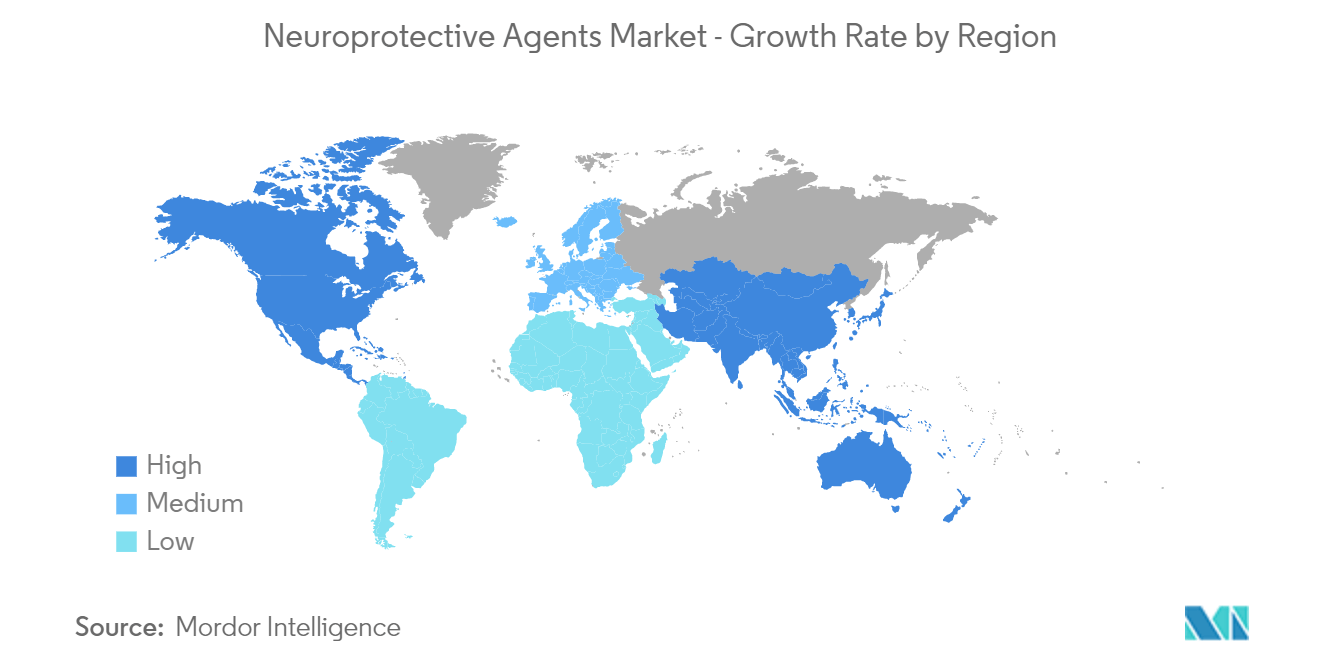
Competitive Landscape
The Neuroprotective Agents Market is fragmented and consists of several major players. In terms of market share, a few of the major players are currently dominating the market. Some of the companies which are currently dominating the market are Merck KGaA, Novartis Pharmaceuticals Corporation, Teva Pharmaceutical Industries Ltd., Genervon Biopharmaceuticals, LLC., Neuren Pharmaceuticals, Pfizer Inc, GlaxoSmithKline plc, Sunovion Pharmaceuticals Inc, Sun Pharmaceutical Industries Ltd., and Hikma Pharmaceuticals PLC.
Global Neuroprotective Agents Industry Leaders
-
Merck KGaA
-
Novartis Pharmaceuticals Corporation
-
Teva Pharmaceutical Industries Ltd.
-
Pfizer Inc
-
GlaxoSmithKline plc.
- *Disclaimer: Major Players sorted in no particular order
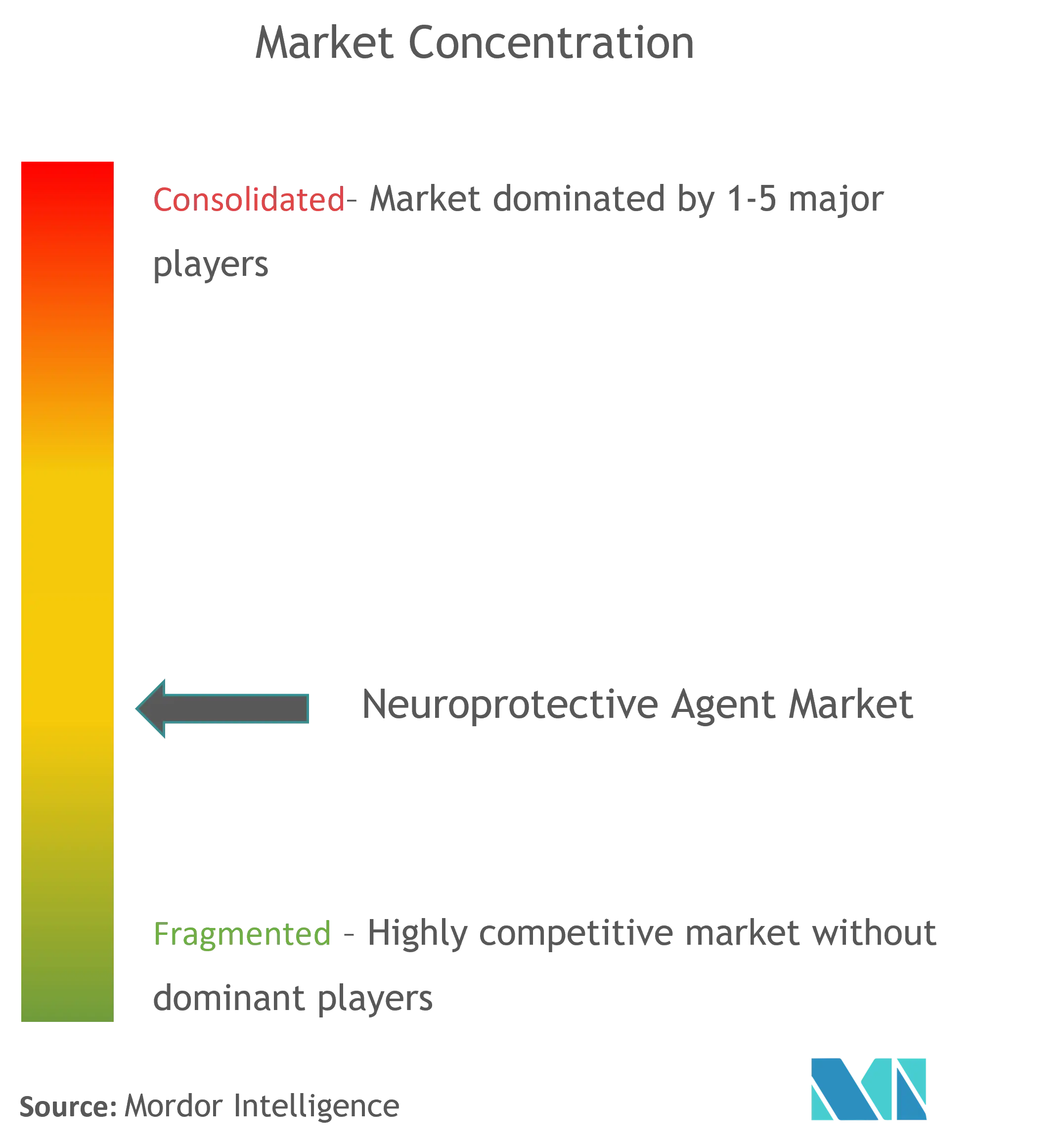
Recent Industry Developments
- In August 2022, BrainStorm submitted a Biologics License Application (BLA) to the Food and Drug Administration for NurOwn as a potential treatment for ALS.
- In August 2022, Incannex Healthcare engaged contract research, development, and manufacturing firm Curia Global to scale up the manufacture of its proprietary pharmaceutical cannabis-based product IHL-216A for the treatment of concussion and traumatic brain injury.
Global Neuroprotective Agents Market Report Scope
As per the scope of this report, neuroprotective agents are the drugs that help to protect brain neurons from degeneration and injury. These medications are used to treat a variety of central nervous system disorders, including Parkinson's disease, Alzheimer's disease, and traumatic brain injuries. The frequency of neurodegenerative illnesses rises dramatically with age. As a result, the demand for neuroprotective is expected to grow in the future as average life lengths rise, creating a substantial market for innovative medications to treat these disorders. The Neuroprotective Agents Market is segmented by Drug Class (Anesthetics, Antagonists, Antidepressants, Cytokines, Others), Application (Alzheimer's disease, Dementia, Epilepsy, Multiple sclerosis), Route of Administration (Oral, Topical, Epidural, Intravenous) By Distribution Channel (Hospital Pharmacies, Retail Pharmacies, Drug Stores, Online Pharmacies) and Geography (North America, Europe, Asia-Pacific, Middle East & Africa, and South America). The market report also covers the estimated market sizes and trends for 17 different countries across major regions globally. The report offers the value (in USD million) for the above segments.
| Anesthetics |
| Antagonists |
| Antidepressants |
| Cytokines |
| Others |
| Alzheimer's disease |
| Dementia |
| Epilepsy |
| Multiple sclerosis |
| Others |
| Oral |
| Topical |
| Epidural |
| Intravenous |
| Hospital Pharmacies |
| Retail Pharmacies |
| Drug Stores |
| Online Pharmacies |
| North America | United States |
| Canada | |
| Mexico | |
| Europe | Germany |
| United Kingdom | |
| France | |
| Italy | |
| Spain | |
| Rest of Europe | |
| Asia-Pacific | China |
| Japan | |
| India | |
| Australia | |
| South Korea | |
| Rest of Asia-Pacific | |
| Middle-East and Africa | GCC |
| South Africa | |
| Rest of Middle-East and Africa | |
| South America | Brazil |
| Argentina | |
| Rest of South America |
| By Drug Class | Anesthetics | |
| Antagonists | ||
| Antidepressants | ||
| Cytokines | ||
| Others | ||
| By Application | Alzheimer's disease | |
| Dementia | ||
| Epilepsy | ||
| Multiple sclerosis | ||
| Others | ||
| By Route of Administration | Oral | |
| Topical | ||
| Epidural | ||
| Intravenous | ||
| By Distribution Cahnnel | Hospital Pharmacies | |
| Retail Pharmacies | ||
| Drug Stores | ||
| Online Pharmacies | ||
| Geography | North America | United States |
| Canada | ||
| Mexico | ||
| Europe | Germany | |
| United Kingdom | ||
| France | ||
| Italy | ||
| Spain | ||
| Rest of Europe | ||
| Asia-Pacific | China | |
| Japan | ||
| India | ||
| Australia | ||
| South Korea | ||
| Rest of Asia-Pacific | ||
| Middle-East and Africa | GCC | |
| South Africa | ||
| Rest of Middle-East and Africa | ||
| South America | Brazil | |
| Argentina | ||
| Rest of South America | ||
Key Questions Answered in the Report
What is the current Global Neuroprotective Agents Market size?
The Global Neuroprotective Agents Market is projected to register a CAGR of 6.7% during the forecast period (2025-2030)
Who are the key players in Global Neuroprotective Agents Market?
Merck KGaA, Novartis Pharmaceuticals Corporation, Teva Pharmaceutical Industries Ltd., Pfizer Inc and GlaxoSmithKline plc. are the major companies operating in the Global Neuroprotective Agents Market.
Which is the fastest growing region in Global Neuroprotective Agents Market?
Asia-Pacific is estimated to grow at the highest CAGR over the forecast period (2025-2030).
Which region has the biggest share in Global Neuroprotective Agents Market?
In 2025, the North America accounts for the largest market share in Global Neuroprotective Agents Market.
What years does this Global Neuroprotective Agents Market cover?
The report covers the Global Neuroprotective Agents Market historical market size for years: 2019, 2020, 2021, 2022, 2023 and 2024. The report also forecasts the Global Neuroprotective Agents Market size for years: 2025, 2026, 2027, 2028, 2029 and 2030.
Page last updated on:
Global Neuroprotective Agents Market Report
Statistics for the 2025 Global Neuroprotective Agents market share, size and revenue growth rate, created by Mordor Intelligence™ Industry Reports. Global Neuroprotective Agents analysis includes a market forecast outlook for 2025 to 2030 and historical overview. Get a sample of this industry analysis as a free report PDF download.
